Table of Content
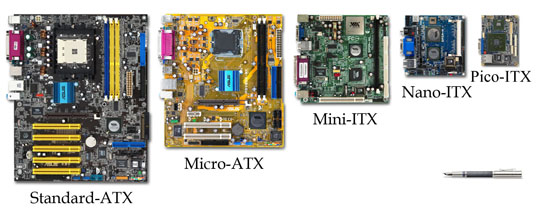
By VIA Gallery from Hsintien, Taiwan - VIA Mini-ITX Form Factor Comparison uploaded by Kozuch
Form Factor Overview
The motherboard is the main component of a computer. It is the large circuit board where all other components of a computer connects to - such as the CPU, memory modules, hard drives, and graphics card. Motherboards come in a variety of different shapes and sizes, which is known as the form factor. In additional to the dimension, a form factor will also dictate the layout and specifications of the ports, expansion slots, mounting holes, power supply, and of motherboard components. There have been a variety of form factors over the decades. However, only the ATX form factor is common today. Regardless of the form factor, each has its own standardized which manufacturers must follow to ensure their parts are compatible with a particular motherboard.
This article will provide an quick overview of today's common ATX form factor, along with some popular from the past.
Back to TopATX Form Factor
The ATX is the most common motherboard form factor used today. ATX is an abbreviation for Advanced Technology eXtended. Many consider the ATX design a vast improvement over the previous standard AT form factor which had limitations. Considering it was released in 1995 by Intel, the fact that it is still the standard today is testament that ATX was ahead of its time. and addresses. The ATX was slow to catch on due to the long-time acceptance of the AT form factor, but it slowly gained popularity. Most motherboards today are ATX and the AT form factor is rarely found today expect in legacy systems.
Some advanced features of the ATX format:
- Integrated I/O Connectors
While the AT uses headers on the board that are attached to the actual ports on the back of the case, the ATX board has the actual ports built right onto the board. This makes installation easier and enhances reliability. This includes an integrated PS/2 mouse connector. - Reduced Overlap Between Board and Drives
The ATX board looks like it is rotated 90 degrees so that it does not overlap the drive bays in the front. This way, one can reach the entire board instead of having to reach around a drive, or even remove the drive, in order to reach certain areas of the motherboard. This also reduces heat. - Reduced Processor Interference with Cards
The processor is moved from the front of the board near the slots to the back, top of the board, near the power supply. This means that a user can install full-length expansion cards in the slot without having to worry about hitting the CPU or heat sink. - User-Friendly Power Connector
ATX uses one 20-pin connector to attach to the motherboard. The ATX connector is also keyed so that it will only go in the correct way. This is easier than the two separate connectors of the AT form which look almost the same. It also gets rid of the problem of frying the board due to misplacement of the connectors on the motherboard. - Better Cooling Conditions
The ATX power supply blows air into the case instead of out. This means that air blows out all the holes in the case and thus keeps dust out. - 3.3 Volt Power
The ATX motherboard is designed to accept 3.3 volt power directly from the power supply. Since almost all modern processors operate at 3.3 volts, this removes the need for a voltage regulator on the motherboard to reduce the voltage from 5V to 3.3V. It must be noted, though, that many processors don't use this voltage, and therefore must use a voltage regulator anyway. - Automated Controls
The ATX power supply is capable of being controlled through software and other means. This is because it always has a slight voltage going through it. This gives the computer the ability to turn itself on at specified times and perform some task given to it by the software. Some ATX motherboards have the option of turning the system on by pressing the space bar on your keyboard or being woken up by a command sent down through the LAN. Lastly, the shut down procedure is automated using ATX. When you choose "Shut Down", the computer will perform all shut down tasks, then turn itself off.
Micro-ATX (mATX) Form Factor
The Micro-ATX (sometimes abbreviated as mATX) motherboards are similar to the ATX board except for its dimension - 9.6" x 9.6" versus 12" x 9.6". Being smaller, mATX form factor boards are ideal for small computer chassis. Because of its smaller size, there are fewer expansion and/or memory slots on mATX motherboards.
Despite being smaller, it does not mean mATX motherboards are less capable or cheaper than a comparable full size ATX motherboard. The ASUS ROG Maximus XI Gene Z390 mATX motherboard is packed with advanced technologies to satisfy the need of gamers and can cost more than many standard size ATX motherboards.
Mini-ITX Form Factor
Released in 2001 and developed by VIA Technologies, the Mini-ITX is even smaller in size (at 6.7" x 6.7") to the Micro-ATX. It was designed to accommodate the growing trend of making computers smaller in size. Because it is much smaller, this form factor is typically not ideal for some computer enthusiast as there is usually just one expansion slot and two memory slots, thus limiting upgrade and add-on options. However, being smaller, Mini-ITX motherboards consumes less power and typically does not require a large cooling component.
Mini-ITX boards are compatible with ATX and Micro-ATX computer cases as the mounting points and back panel are located in the same position on the circuit board. Variants to the ITX form factor later emerged that includes the Nano-ITX in 2003, the Mobile-ITX in 2007, and the Pico-ITX also in 2007. All are designed for low-cost, low-profile computers and devices.
Back to TopBTX Form Factor
The BTX form factor was released by Intel 2004 as a replacement to ATX that incorporates feature such as a new layout design to allow for better airflow and newer technologies to accommodate higher power consumption. BTX (an abbreviation for Balanced Technology eXtended) form format was not widely adopted despite the benefits it offer. This was primarily due to the increase in more energy-efficient components such as CPUs and GPUs. These effectively negated the primary benefits BTX offered.
The original BTX specification was compatible with ATX computer cases and power supplies. However, the specification was later changed and it required BTX-compatible cases and power supply unit. Despite its benefits, BTX was not wide adopted and in 2006, Intel announced it was discontinuing development of BTX.
Back to TopNLX Form Factor
The NLX (an abbreviation for New Low Profile eXtended) form factor was created by Intel for low-cost and low-profile computers in the late 1990's. Because computers with NLX motherboards are slim, a riser board is used to accommodate expansion cards in such a tight space. It does this by allowing add-on cards to be seated parallel to the motherboard instead of perpendicular to it as with ATX for mATX boards.
NLX was not widely adopted and was superseded by the Micro-ATX and Mini-ITX form factors.
Back to TopExtended ATX (EATX) Form Factor
The EATX (an abbreviation for Extended ATX) is a variant of the ATX form factor. This standard defines a larger motherboard circuit board. As a result, more expansion slots can be accommodated (such as 8 instead of 4 on an ATX) along with more memory slots. These motherboards aren't commonly found on consumer motherboards but more on servers.
Back to TopAT and Baby-AT Form Factors
The AT form factor was developed by IBM and was the common form factor of the 1980s. AT is an abbreviation for Advanced Technology and this form factor comes in two flavors - AT (sometimes referred to as Full-AT) and Baby AT. The two basically differ in size. An AT motherboard is about 12" x 13.8" which means it can't fit in many of today's cases. AT form factor motherboards were used for the Intel 80386 or earlier processors and was the dominated form factor in the 1980s. Despite its popularity, it did have its drawbacks. For computer technicians, working inside a computer case with an AT board was troublesome as its large size was often overlapped by the drive bays making installation and access to various connectors difficult. The AT is the oldest and largest form factor until the introduction of Baby-AT.
Baby AT was the form used by many boards and cases at the time. Many Socket 7 and Pentium-class boards use this form factor. A Baby AT board is approximately 8.5" wide and 13" long. The size varies a little from board to board. This reduced size made it easier to work inside the case simply because there is more room. There are three rows of mounting holes to hold the board in the case.
AT form boards share common traits. They all have serial and parallel ports (no longer common today) attached to the case in an expansion slot and connected to the board through cables. They also have a single keyboard connector soldered onto the board at the back of the board. The processor is still at the front of the board and can sometimes get in the way of expansion cards. The SIMM slots (memory slots) are in different places, although they are almost always at the top of the board.
There are some annoyances with the AT design that eventually emerged since its introduction. One was due to the layout. Since all input ports are attached to the case and then connected to the motherboard via a cable, the board must have connectors for all of them - such as: COM 1, COM 2, printer port, USB, and PS/2 mouse. Often these connectors are directly next to the IDE channel connectors (for hard drives) and floppy drive connector. This leads to a severe cramping problem and makes working inside the computer more difficult.
Additionally, the AT design is not conducive to efficient cooling of the system. Air is not blown over the areas that need it, namely the CPU. Also, the air flow draws in dust. Over time, the AT power supply will get dusty and the inside of the system will be coated with a layer of dust. For this reason, it was recommended that the computer case was to be removed regularly blow off the interior of the case.
The AT form factor was retired when ATX was introduced by Intel in 1995.
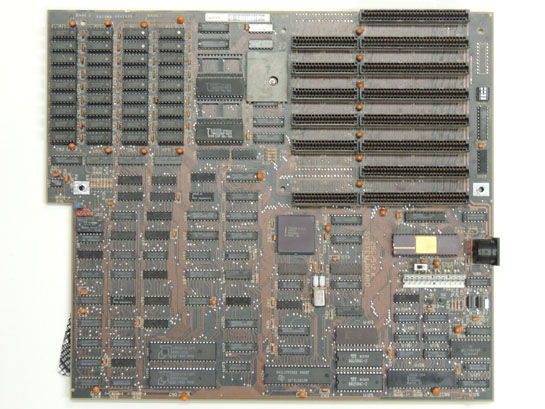
By Rmyers7 - Own work, CC BY-SA 4.0, Link
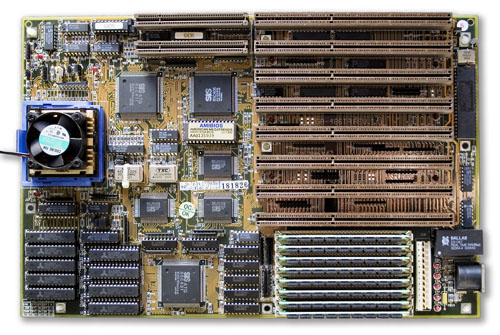
By Andrew Dunn - Own work, CC BY-SA 2.0, Link
XT Form Factor
The XT (an abbreviation for eXtended Technology) was the first form factor introduced in 1983 by the then popular IBM Personal Computer XT, or simply IBM XT.
The IBM XT was intended for business users and can cost up $3,000 USD and more at the time, or about $7,800+ USD in 2019 after factoring in inflation. Additionally, the XT weighed approximately 32 pounds.
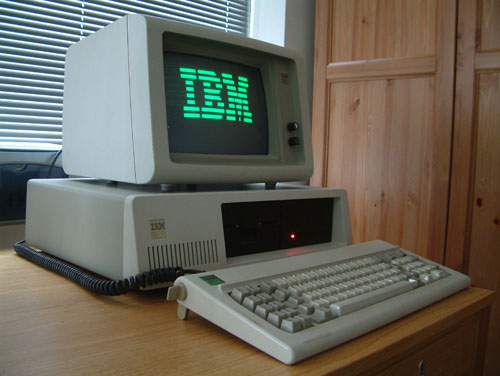
By Ruben de Rijcke - http://dendmedia.com/vintage/ - Own work, CC BY 3.0, Link
Other Form Factor
The form factors listed is not all encompassing. Described here are the standards that are/were popular or worth noting. There are many other form factors developed over the past decades that are not included such as Flex ATX, LPX, Mini-LPX, DTX, WTX, and ETX to name a few.
Back to TopForm Factor Summary
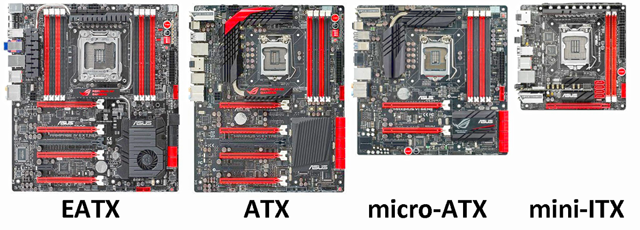
| ATX | EATX | BTX | Micro-ATX | Mini-ITX | Nano-ITX | Pico-ITX | Mobile-ITX | NLX | AT | Baby AT | XT | |
|---|---|---|---|---|---|---|---|---|---|---|---|---|
| Dimension* | 12 x 9.6" | 12 x 13" | 12.8 x 10.5" | 9.6 x 9.6" | 6.7 x 6.7" | 4.7 x 4.7" | 2.8 x 3.9" | 2.4 x 2.4" | 8 x 10" | 12 x 13.8" | 8.5x 10" | 8.5 x 11" |
| Power Connection | 20- or 24-pin connector | 24-pin connector | 24-pin connector | 24-pin connector | 4-pin, 24-pin connector, or DC jack | 20-pin connector | Two 6-pin connectors | |||||
| Expansion Slots | Many | Many | Few | Few | Few | 1 | 0 | 0 | Limited | Many | Many | Many |
| Released Date** | 1995 by Intel | 2004 by Intel | 1996 | 2001 by VIA | 2003 by VIA | 2007 by VIA | 2007 by VIA | 1999 by Intel | 1984 by IBM | 1985 by IBM | 1983 by IBM |
* Actual motherboard dimension varies between manufacturers
** Released/introduced

